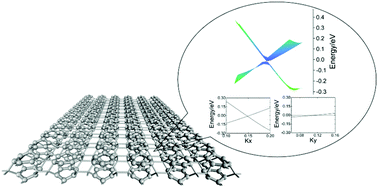Nano-makisu: highly anisotropic two-dimensional carbon allotropes made by weaving together nanotubes†
Abstract
Graphene and carbon nanotubes (CNT) are the representatives of two-dimensional (2D) and one-dimensional (1D) forms of carbon, both exhibiting unique geometric structures and peculiar physical and chemical properties. Herein, we propose a family or series of 2D carbon-based highly anisotropic Dirac materials by weaving together an array of CNTs by direct C–C bonds or by graphene ribbons. By employing first-principles calculations, we demonstrate that these nano-makisus are thermally and dynamically stable and possess unique electronic properties. These 2D carbon allotropes are all metals and some nano-makisus show largely anisotropic Dirac cones, causing very different transport properties for the Dirac fermions along different directions. The Fermi velocities in the kx direction could be ∼170 times higher than those in the ky direction, which is the strongest anisotropy among 2D carbon allotropes to the best of our knowledge. This intriguing feature of the electronic structure has only been observed in heavy element materials with strong spin–orbit coupling. These results indicate that carbon based materials may have much broader applications in future nanoelectronics.



 Please wait while we load your content...
Please wait while we load your content...
